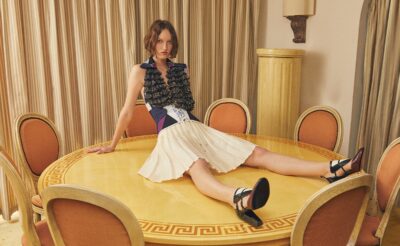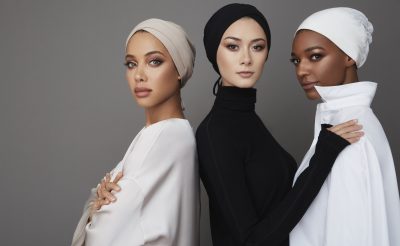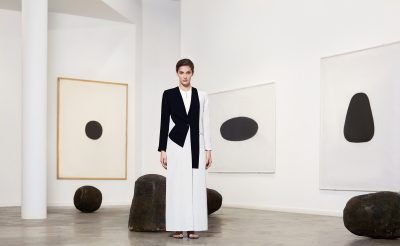Sustainability is an ingrained ideology in many faith-based labels, and will drive the future of modest fashion, argues Hafsa Lodi
The social and political events unfolding over the past year have prompted a number of global protests, even while in the midst of a worldwide pandemic. And although the fashion world has long remained removed from some of the more serious crises that plague our world, designers and entrepreneurs in the realm of modest fashion are embracing accountability, shaping up and spearheading change when it comes to one critical concern: making the industry more conscious and sustainable.
“Green is the new black” and “Ethical is the new normal” were the slogans scrawled on placards held by models walking down the catwalk robed in designs by Rabia Zargarpur for Turkish e-commerce platform Modanisa, during Istanbul Modest Fashion Week in 2019. “It was important to be loud about it, as not everybody understands the importance of sustainable modest fashion,” Zargarpur tells MOJEH. “At Rabia Z, we have always been an ethical brand that was and is sustainable to the best of our ability, long before sustainability became a buzzword.” The Emirati designer fist conceptualised her label in California almost two decades ago, and has since been a trailblazing force in modest fashion – from authoring the modest fashion segment of the 2017- 2019 State of the Global Islamic Economy Report by DinarStandard and Thompson Reuters, to seeing her signature breathable hijab showcased at the traveling Contemporary Muslim Fashions exhibition that launched at the DeYoung Museum of Fine Arts in San Francisco, and is now at New York’s Cooper Hewitt, Smithsonian Design Museum.
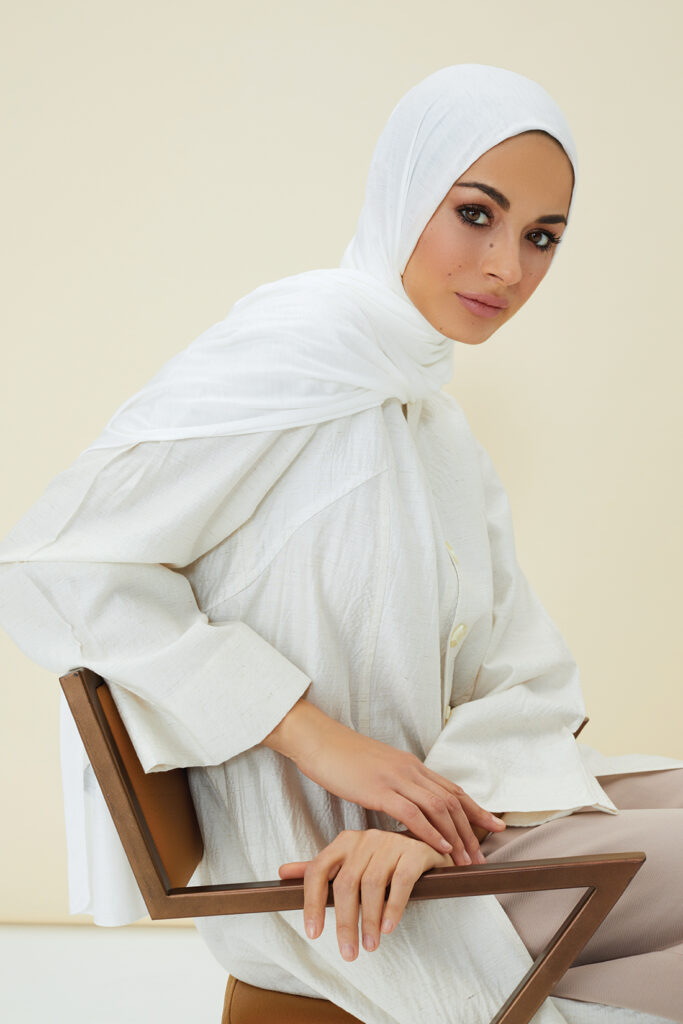
Rabia Z uses biodegradable fabrics in an effort to reduce needless waste
Zargarpur explains that working with sustainable and biodegradable fabrics has been integral to her brand ethos from the very beginning, as is minimising israf, or needless waste, which is an aspect of Islamic economic practice. Within the niche of modest fashion, sustainability is, after all, a particularly relevant criterion, because it corresponds with key Islamic ideologies. When I interviewed leading American headscarves brand Haute Hijab’s CEO Melanie Elturk for my book, Modesty: A Fashion Paradox, she explained why modesty and sustainability share a supreme synergy: “It’s so part and parcel of our values as Muslims that it should be a given with any Muslim-owned company: when it comes to labour, wages, fair trade, sustainability, all those things are Islamic principles that we should all be adhering to,” she stated. “As Muslims, we want to be part of the solution and not the problem. We’re custodians of this Earth and we’re going to have to answer for everything we did here.”
Our roles as “custodians of the Earth” is a phrase that Aneesa Zaman, designer for UK-based modest swimwear label Sei Sorelle, also references. In fact, she cites this duty as a major motivator for her brand, which she says is the first modest swimwear company in the United Kingdom to adopt sustainable practices. “Right from the start we were aware of our responsibility as custodians of the Earth, and protecting the environment is integral to our beliefs. So, a core focus for our brand is to try and make each and every process as sustainable as possible,” she explains. While modest fashion may attract women of all faiths, along with women who don’t identify as religious at all, the movement has gained momentum due to the spending power attributed to Muslim-majority demographics in the Middle East that are both wealthy and adhere to cultural dress codes. The 2020/2021 State of the Global Islamic Economy Report estimates the modest fashion market’s value will be $402 billion by 2024, and states: “Whether through the use of eco-friendly raw materials or technology, sustainability and ethics are now increasing in importance.” Millennials, one of the key consumer groups of modest fashion (and those projected to have the most spending power) are driving the demand for sustainability. A 2018 Business of Fashion study found that 66 percent of millennials globally are willing to spend more on fashion that’s sustainable.
Numerous stylish, socially aware and environmentally in-tune women in the modest fashion realm are indeed becoming more conscious when it comes to shopping. A Dubai-based modest fashion influencer and founder of upcoming digital magazine Modesteen, says that sustainability is one of the key areas of growth for the industry’s future. “Now that the excitement of having choices in clothing is starting to fade, we need to look at sustainability, the environmental concerns, and the fabrics being used. We now have fashion that serves us, and we have our share of voice in the market, but the next question is, ‘How do we consume in a more ethical way?’”
Many of the ideals of modest fashion are also in sync with minimalism, a style movement that promotes less consumption and is humble, simple and often neutrally toned in aesthetic. From some points of view, both modesty and minimalism are similar in the sense that fashion is not flamboyant or overly eye-catching, but more importantly, minimalism as an ideology takes a stance against fast fashion. Zargarpur believes that championing slow fashion, in line with ethical and sustainable principles, is easily achievable for fashion brands today, starting with the fabrics they use. “Sourcing sustainable fabrics now is much easier than it was a decade ago, with much more variety and accessible price ranges. So there really is no excuse if one is serious about minimising their carbon footprint, water wastage, pollution, and harm to the environment,” she says.

Sabirah was launched by Deborah Latouche at London Fashion Week in 2020
As we turn new corners in fashion, the sectors of modesty and sustainability are poised to converge like never before. For starters, the pandemic is impacting how we approach fashion – and not only by prioritising comfortable clothing to suit a new #WFH lifestyle. “The pandemic has highlighted even more the need to care for the environment and others,” says London-based stylist and designer Deborah Latouche, who launched her modestwear label, Sabirah, at London Fashion Week in 2020. “For me, modesty is not just about the way a person dresses, it is also about their character. Sustainability ties in with this and is a core aspect of Sabirah – being aware of how your clothes are made, what they are made of and being conscious of how you spend your money.” A hallmark of pro-sustainability designers is their penchant for utilising fabrics to their fullest extents and adapting to the demands of their consumers, especially during the trying times brought about by the pandemic. “We launched in February 2020, just before the first lockdown. Therefore this ‘new world’ we live in is all the brand has known,” explains Latouche. Her designs make up a “continuous capsule collection,” crafted from repurposed, high-end fabrics and vintage buttons. She recently introduced matching face-masks to her range. “I was getting really frustrated by all the disposable masks that were thrown everywhere,” she says. “If anything, the pandemic really exposed the need to care for the environment, so it only seemed right to use up excess fabric to make limited-edition, reusable and beautifully made masks in luxurious fabrics to protect our customers.”
Other brands are leading innovation with their sustainable headscarves. Mid-pandemic, Haute Hijab launched a diverse and dynamic range of sustainable sports hijabs. Sustainability is an area the designer is keen to explore further. In 2019, she created a role called ‘director of design and innovation’ at the brand, and is looking into ways to create hijabs from sustainable materials such as rose petals, mushrooms and coffee grounds. There’s also Under-Râpt, by British-Egyptian designer Yasmin Sobeih, which claims to be the world’s first modest, sustainable sports and athleisure label. Sobeih first conceptualised a sports hijab in 2015, two years prior to Nike’s Pro Hijab launch. Her textiles are all organic and eco-friendly, and her supply chain prioritises transparency and ethics throughout all aspects of the production process.
Besides ready-to-wear and athletic wear, swimwear is a thriving market within the modest fashion sector, and presents its own challenges with sustainability. Sei Sorelle’s Zaman explains that nylon, which is the most widely used fabric for swimwear, is a major contributor to air pollution and damages the Earth’s ozone layer. “This led us to discover ECONYL regenerated nylon, which is woven into a high-quality, soft techno-fabric designed for swimming and activewear. What’s great is that it is made from waste collected from oceans and landfills, meaning our first collection alone has removed 624kg of waste,” she says. Beyond merely using eco-friendly fabrics, Sei Sorelle’s packaging and hang tags are all recyclable and made of recycled materials, while its hygiene liners and stickers are biodegradable. Packaging is a category often overlooked, yet due to wastage, remains a crucial area for implementing sustainability. “Our packaging includes eco-friendly totes for our precious pieces – sustainability is the very core essence of our brand,” says Dubai-based Naila Arshad of new modestwear brand Naz The Label. “From accessories to packaging, our brand takes even the slightest bits of salvaged materials to make the most out of them.” Like Latouche, Arshad also turned to mask-making during the pandemic, and even introduced scrunchies to her range, all made from excess fabrics.
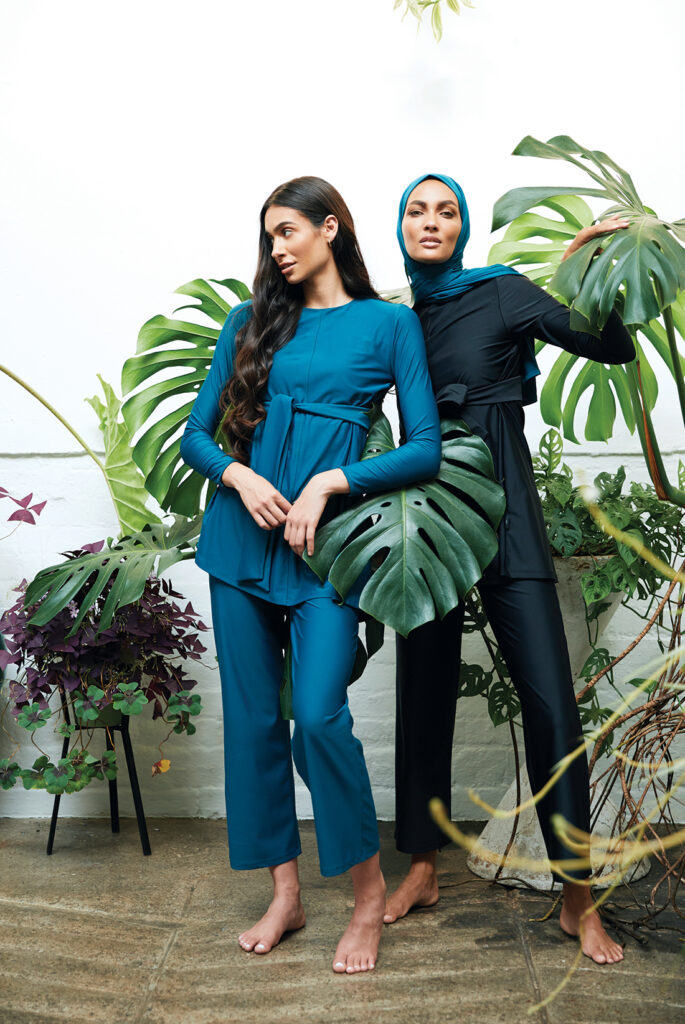
Sei Sorelle offers modest, sustainable swimwear
Mariah Idrissi, who became the world’s first mainstream hijabi model when she was recruited for an H&M campaign in 2015, says that the pandemic has given us all time to pause and reflect on how we consume. She believes the ideals of sustainability are inextricably linked with the principles of Islam, and that the onus is on retailers to promote a top-down approach to making sustainable fashion more accessible. Idrissi names H&M, which produces a dedicated ‘Conscious’ line, and ASOS, which has a tab on its website with an edit of sustainable options that’s constantly updated with new offerings, as examples for other labels to follow. “I think brands should take leadership and implement it because they’re in the fashion industry. Just because we wear clothes doesn’t make us all fashion gurus – a lot of people don’t know or care about the ins and outs of fashion, whereas if you’re a brand or designer, it is your responsibility to raise awareness for people to help create that sort of demand,” she explains.
“Clothing sustainability is growing in popularity with consumers and has also been the theme of many modest fashion events,” notes the 2020/2021 State of the Global Islamic Economy Report. When Amsterdam Modest Fashion Week took place in 2020, sustainability was one of its three key themes (the others being self-discovery and tolerance). Although the pandemic may have put a halt to live, in-person fashion events, Idrissi believes they can be instrumental in helping raise community awareness about the importance of sustainability in fashion. Just weeks before Covid-19 hit the shores of the UAE, she spoke at the 2020 Middle East Youth Expo in Abu Dhabi, and says that many attendees were completely unaware of what sustainable fashion entails. “We’re promoting something that’s Islamic, basically,” she says, “but so many had no idea what sustainability even is. We need more events and panels, even if they’re just classroom-sized, to help spread the ideas that it isn’t taboo to wear vintage, second-hand or recycled clothes.”
“We need to think about investment pieces instead of fast fashion, or buying vintage, or repurposing and re-styling what you already own,” agrees Latouche. The designer admits that the community still has a long way to go, but says that with patience, we will get there. It was with patience, after all, that modesty-conscious consumers waited decades for their style preferences to be embraced by the mainstream, and with the perseverance of change-makers in the industry, the hope is that sustainability will become equally in-vogue as a lifestyle practice.
Placing placards with pro-sustainability slogans in the hands of models dressed in stylish modestwear as they stomp down runways, is certainly one way to draw attention. “I cannot emphasise enough the importance of sustainability in a post-pandemic world and in the future of both mainstream and modest fashion industries,” says Zargarpur. “It is the future. No one is perfect, but if we all start slowly somewhere, collectively that can have a big and positive impact, God willing.”
Read Next: Hafsa Lodi On What’s Fuelling The Modest Fashion Movement

